How to Choose the Best Layout for a Functional Kitchen

How to Choose the Best Layout for a Functional Kitchen The layout of your kitchen plays a crucial role in creating a space that’s both functional and inviting. Whether you’re designing a new kitchen or remodeling an existing one, a well-thought-out layout can enhance your cooking experience, optimize storage, and create a welcoming space for socializing. In this guide, we’ll walk you through the key factors to consider when choosing the best layout for a functional kitchen, ensuring that your kitchen works as beautifully as it looks. 1. Consider Your Kitchen Work Triangle One of the fundamental principles of kitchen design is the kitchen work triangle. This concept refers to the optimal placement of the three primary work areas: the sink, stove, and refrigerator. These three elements should form a triangle to ensure an efficient flow between tasks. Why the Work Triangle Matters? The work triangle minimizes unnecessary movement, allowing you to transition smoothly between prepping, cooking, and cleaning. When these elements are placed too far apart or too close together, it can hinder the efficiency of your kitchen. Common Mistakes to Avoid Overstretching the Triangle: If the points of the triangle are too far apart, it can make cooking feel cumbersome. Crowding the Triangle: Placing elements too close together may cause the kitchen to feel cramped, especially if more than one person is using the space. Pro Tip: Keep the sides of the work triangle between 4 and 9 feet for the best kitchen flow. 2. Popular Kitchen Layout Types Different homes and lifestyles require different kitchen layouts. Each layout comes with its own set of pros and cons, and choosing the right one depends on the size and shape of your kitchen, as well as how you plan to use the space. Common Kitchen Layout Styles Galley Kitchen: Ideal for small spaces, the galley kitchen features two parallel walls with countertops and appliances on each side. This layout maximizes efficiency in narrow spaces but can feel tight for multiple cooks. L-Shaped Kitchen: Great for open floor plans, this layout features counters on two adjoining walls, forming an “L.” It’s perfect for corner spaces and allows for more open flow in larger kitchens. U-Shaped Kitchen: This layout surrounds the cook on three sides, providing ample counter space and storage. It’s an excellent choice for those who need a lot of workspace but works best in larger kitchens. Island Layout: Ideal for larger kitchens, an island adds extra counter space and storage. It also creates a natural gathering place for socializing while cooking. Choosing the Right Layout The layout you choose should complement the size and function of your kitchen. For smaller kitchens, the galley or L-shaped design offers great efficiency. If you have more space, a U-shaped or island layout allows for more flexibility and social interaction. 3. Maximize Storage and Counter Space No matter the layout, one of the most important elements of a functional kitchen is having enough storage and counter space. Without these, even the most stylish kitchen can feel cluttered and inefficient. Smart Storage Solutions Pull-Out Drawers: These maximize deep cabinet spaces and make it easy to access pots, pans, and pantry items. Built-In Cabinets: Incorporate cabinets that reach the ceiling for extra storage, and don’t forget about under-island storage or pantry solutions. Floating Shelves: These can add extra storage while also offering a place to display decorative kitchenware. Importance of Counter Space Ample counter space is essential for meal prep and day-to-day kitchen tasks. Aim to keep countertops clutter-free, and if space allows, an island or breakfast bar can add extra working surfaces. 4. Traffic Flow and Accessibility A well-designed kitchen layout should allow for easy movement, especially if more than one person is cooking or gathering in the kitchen at once. Designing for Traffic Flow Open Layouts: For families or those who entertain often, an open layout allows people to move freely between the kitchen, dining, and living spaces. Consider the placement of seating and the island to ensure that guests or family members don’t disrupt the kitchen’s workflow. Accessibility Considerations For homes where accessibility is important, design features like lower countertops, pull-out shelves, and wide walkways can help ensure everyone can use the kitchen comfortably. Make sure doorways and pathways are wide enough to accommodate mobility aids, and that appliances are within easy reach for all members of the household. 5. Customize for Lifestyle and Aesthetic Every kitchen should reflect the personal style and unique needs of the homeowner. Customizing your kitchen layout can enhance both its functionality and beauty, making it a space you love to use every day. Personalizing Your Kitchen Layout Lighting: The right lighting can make or break a kitchen’s functionality. Incorporate task lighting under cabinets for better visibility during food prep, and pendant lights over islands or dining areas to enhance ambiance. Appliances: Choose appliances that fit both your lifestyle and your kitchen layout. For example, if you entertain frequently, consider larger cooking appliances or a second dishwasher for easy cleanup. Aesthetic Touches: Don’t forget about design elements like countertops, backsplashes, and cabinetry finishes that tie the entire space together. These not only add beauty but can also enhance your kitchen’s durability and ease of use. Conclusion Choosing the best layout for your kitchen is key to creating a space that’s both functional and stylish. By considering your work triangle, optimizing storage, and ensuring good traffic flow, you’ll be well on your way to a kitchen that enhances your cooking, entertaining, and everyday life. Ready to transform your kitchen? Explore Michigan Rose Construction’s kitchen remodeling services and schedule a consultation for personalized design advice. Call us at (734) 307-2019 or fill out our contact form today! NameEmailPhoneAddress*Files & PhotosLead SourceHow did you hear about us?FacebookGoogleInstagramInternet SearchReferralWebsiteYelpYardReachNotesTell us about your project!NotesWhat days and times work for you for an on-site consultation?Submit FREQUENTLY ASKED QUESTIONS: What is the “kitchen work triangle,” and why is it important? The kitchen work triangle is a design concept that positions the sink,
The Step-by-Step Guide to Planning Your Dream Kitchen

The Step-by-Step Guide to Planning Your Dream Kitchen Planning a kitchen remodel is both exciting and challenging. Whether you’re looking to modernize your space, improve its functionality, or simply give it a fresh look, the process requires careful planning. At Michigan Rose Construction, we understand that a well-planned kitchen can become the heart of your home, offering both aesthetic appeal and practical use. In this step-by-step guide, we’ll walk you through the essential aspects of kitchen remodeling, from evaluating your needs to working with professionals who can bring your vision to life. By the end of this guide, you’ll know how to balance your dream kitchen’s “must-haves” with those “nice-to-haves,” ensuring the perfect outcome. Understanding the Difference Between Needs and Wants When starting your kitchen remodel, it’s essential to differentiate between your needs and your wants. This not only helps keep your project on budget but also ensures that your kitchen will function as well as it looks. What Are “Needs” in a Kitchen Remodel? Your needs are the foundational elements of the kitchen—those that directly impact the room’s functionality and safety. This includes essential components like: A well-planned kitchen layout (the work triangle between sink, stove, and refrigerator) Adequate storage and counter space Proper lighting and ventilation Safe, durable materials Defining Your “Wants” Wants, on the other hand, are the aesthetic features that enhance the kitchen’s overall feel. These may include: High-end appliances Custom cabinetry Premium countertops like quartz or granite Luxurious fixtures or finishes While these additions can elevate your kitchen, it’s crucial to weigh them against your budget and ensure that your needs are covered first. Evaluate Your Current Kitchen Layout and Functionality Before diving into design choices, take a step back and evaluate your current kitchen. How does it serve you? What frustrations do you encounter daily? These insights will help guide the remodel and make sure that functionality remains at the forefront of your design. Checklist of Essential Features for a Functional Kitchen As you assess your space, consider the following elements of a functional kitchen design: Work Triangle: Does your kitchen have a logical flow between the stove, sink, and refrigerator? Storage Solutions: Are there enough cabinets and pantry space for your needs? Would pull-out drawers or lazy Susans make storage easier? Countertop Space: Do you have enough workspace to prepare meals comfortably? Traffic Flow: Does the layout accommodate movement for more than one person in the kitchen at a time? Once you’ve identified these factors, you’ll be better equipped to create a design that fits your lifestyle. Budget Planning for Your Kitchen Remodel Your budget is the foundation of your remodeling project. Setting a realistic budget early on helps you distinguish between what you need and what you want. How to Allocate Your Budget? We recommend breaking your kitchen renovation budget down as follows: 60% for Needs: This includes structural changes, essential fixtures, and necessary upgrades. 40% for Wants: These are the design features and upgrades that add luxury but aren’t essential to the kitchen’s functionality. Keeping this balance will help you avoid overspending while ensuring that you still get those high-end features you’re dreaming of. Tips for Smart Budgeting Prioritize essential upgrades like plumbing and electrical work to prevent future issues. Shop around for quality materials that fit your budget. Allocate some budget for unexpected expenses, which are common in any remodel. Prioritize Based on Lifestyle and Usage Every family uses their kitchen differently, so it’s crucial to prioritize based on your specific needs. Whether you’re an avid cook, a large family that needs more seating, or someone who loves to entertain, your kitchen should reflect how you use it. Considerations for a Personalized Kitchen Design For Home Chefs: You may want to prioritize high-end appliances, durable countertops, and a larger prep space. For Large Families: Consider additional counter space, storage solutions, and an open layout that allows for easy movement. For Entertainers: An island with seating or a bar area might be more important than additional storage. By focusing on features that will improve your daily life, you can ensure that your kitchen is both beautiful and functional. Seek Professional Advice Planning a kitchen remodel can be overwhelming. That’s why working with a professional kitchen remodeling contractor is essential. Not only can experts like Michigan Rose Construction help you avoid costly mistakes, but they can also offer design insights you may not have considered. Why Consult a Professional? Avoid Costly Mistakes: Professionals can help you navigate building codes, permits, and technical challenges, preventing future headaches. Maximize Your Investment: A contractor can ensure that your kitchen remodel stays on budget while adding value to your home. Customized Solutions: Experienced designers can offer personalized suggestions that match your lifestyle and enhance functionality. At Michigan Rose Construction, we specialize in helping clients throughout Michigan turn their dream kitchens into reality. From the initial planning stages to the final touches, we ensure that your kitchen is both functional and stunning. Conclusion A kitchen remodel is a significant undertaking, but with careful planning and the right team by your side, it can be an exciting transformation. By distinguishing between your needs and wants, evaluating your current layout, and working with professionals, you’ll be well on your way to achieving the kitchen of your dreams. Ready to start planning your dream kitchen? Contact Michigan Rose Construction today to schedule a consultation. Whether you’re in the early stages of planning or ready to dive into the remodeling process, our team is here to help. Call us at (734) 307-2019 or fill out our contact form, and let’s bring your kitchen vision to life! NameEmailPhoneAddress*Files & PhotosLead SourceHow did you hear about us?FacebookGoogleInstagramInternet SearchReferralWebsiteYelpYardReachNotesTell us about your project!NotesWhat days and times work for you for an on-site consultation?Submit FREQUENTLY ASKED QUESTIONS: How can I ensure my kitchen layout works for my family’s needs? Consider your lifestyle and daily kitchen use. For example, large families may need extra seating and counter space, while avid cooks might prioritize high-end
How to Set a Realistic Budget for Your Kitchen Remodel
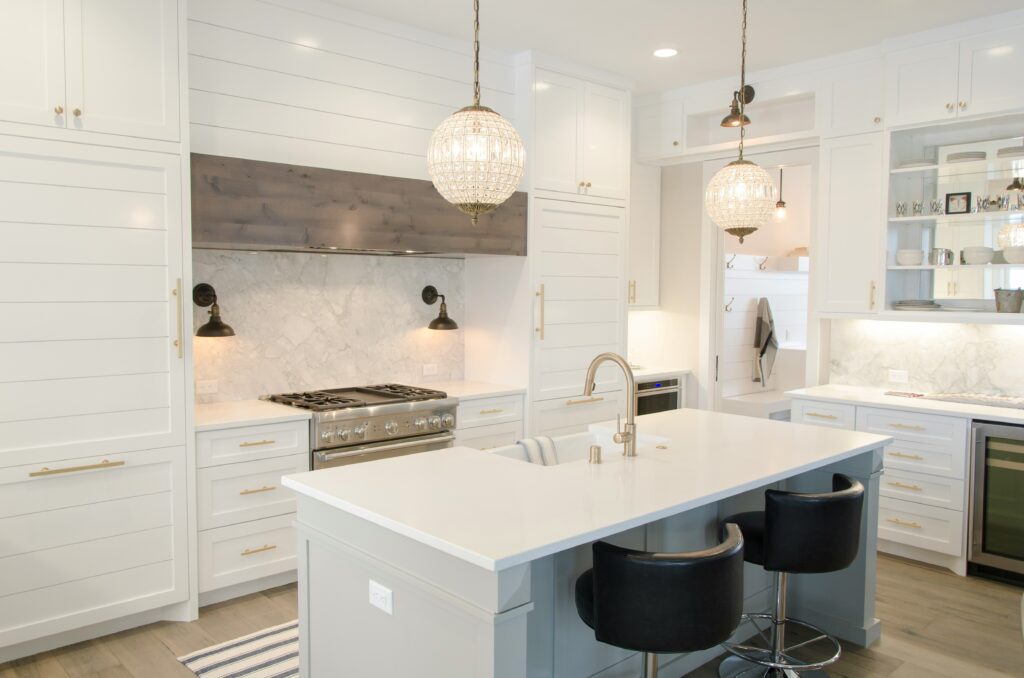
How to Set a Realistic Budget for Your Kitchen Remodel A kitchen remodel is one of the most rewarding investments you can make for your home, but it also comes with its fair share of financial challenges. The foundation of a successful remodel lies in setting a realistic budget. By defining your priorities and planning ahead, you can ensure that your project stays on track and minimize any unexpected surprises along the way. In this guide, we’ll walk you through the steps to create a kitchen remodel budget that aligns with your vision and helps you get the most out of your investment. Determine Your Priorities The first step in any kitchen remodel is understanding what’s most important to you. Is your main goal to enhance functionality? Or are you more focused on aesthetic upgrades, like custom cabinetry or high-end appliances? Determining your priorities will help guide how you allocate your budget. How Prioritizing Helps Your Budget? Once you’ve identified your top priorities, you can start dividing your budget accordingly. For example, if you prioritize functionality, it might make sense to allocate more to cabinets, countertops, and appliances that improve how your kitchen works for you on a daily basis. On the other hand, if aesthetics are your focus, investing in premium materials and finishes might take precedence. Take the time to discuss your must-haves with your contractor to ensure your budget reflects these priorities. Research Average Costs Before diving into the details of your remodel, it’s essential to understand what you can expect in terms of costs. The price of a kitchen remodel can vary widely based on factors like the size of your kitchen, the scope of the project, and where you’re located. Typical Kitchen Remodel Costs Here’s a general overview of common cost factors: Labor: The cost of skilled labor is a significant portion of any remodel, often accounting for 20-30% of the total budget. Materials: Cabinets, countertops, flooring, and other materials can range from budget-friendly options to high-end luxury choices. Unexpected Costs: Things like hidden structural issues or outdated plumbing or wiring can add unforeseen expenses. Doing thorough research on typical kitchen renovation costs in Michigan will give you a solid starting point for your budget. Allocate Your Budget by Category Once you have a rough estimate of your overall budget, it’s time to break it down by category. A percentage-based approach can help ensure you’re spending wisely. Suggested Budget Allocation Cabinets: 30% of your budget should go toward cabinets, as they often serve as the focal point of the kitchen. Labor: Plan to allocate 20% to cover the cost of hiring skilled professionals. Appliances: Set aside about 15% for appliances, especially if you’re opting for energy-efficient or high-end models. Countertops: Another 10-15% should go toward durable and stylish countertops, like quartz or granite. Other Costs: The remaining portion can cover flooring, fixtures, and lighting. Where to Splurge and Where to Save? Consider splurging on items that have a significant impact on daily use, like countertops and appliances. Meanwhile, you can save on fixtures and lighting by opting for more budget-friendly options that still look great. Plan for Unexpected Costs No matter how well you plan, unexpected costs can arise. Whether it’s an issue with old wiring or plumbing, or something as simple as needing additional materials, it’s essential to leave room in your budget for contingencies. How Much to Set Aside? We recommend setting aside 10-20% of your total budget for unexpected expenses. This will give you the flexibility to handle any surprises without derailing the rest of your project. Common Hidden Costs Some of the most common unexpected expenses include: Plumbing and Electrical Upgrades: Older homes may require updates to meet modern building codes. Structural Repairs: Hidden issues with walls, floors, or ceilings can quickly add up. Permit Fees: Be sure to account for any permits required for your remodel. Choose Quality Over Quantity When setting your kitchen remodel budget, it’s tempting to cut costs by opting for cheaper materials. However, investing in high-quality, durable products will save you money in the long run by reducing the need for future repairs or replacements. The Benefits of Quality Materials Durability: High-quality countertops, flooring, and cabinetry can withstand wear and tear and maintain their appearance for years to come. Energy-Efficiency: Investing in energy-efficient appliances may cost more upfront, but they offer long-term savings on your utility bills. Quality materials not only improve the look and functionality of your kitchen, but they also add value to your home, making it a smart investment. Get Multiple Estimates When you’re ready to move forward with your kitchen remodel, obtaining multiple estimates is a smart way to compare prices and services. However, it’s important to focus not just on the cost but also on the expertise and value a contractor brings to the table. Why Choose Michigan Rose Construction? At Michigan Rose Construction, we provide transparent, detailed estimates that outline every aspect of your kitchen remodel—from demolition to installation—so there are no surprises along the way. We pride ourselves on delivering exceptional craftsmanship, tailored to your specific needs, and backed by our solid reputation in Michigan’s construction industry. When you request an estimate from us, you’re not just getting a price—you’re gaining a trusted partner dedicated to making your dream kitchen a reality. Tips for Evaluating Contractor Bids Look Beyond Price: While it’s important to compare estimates, make sure you’re also considering the contractor’s reputation, experience, and attention to detail. Scope of Work: Ensure that the bid covers every stage of the project, so you know exactly what you’re paying for. Timeline: Discuss the estimated timeline to ensure the project will be completed within a reasonable timeframe. Stick to Your Budget Once you’ve set your budget and started the remodeling process, sticking to it is essential to ensure the project doesn’t spiral out of control Tips for Staying on Track Avoid Scope Creep: It’s easy to get carried away with additional upgrades once the remodel is underway. Stick to
7 Common Mistakes to Avoid When Planning a Kitchen Remodel
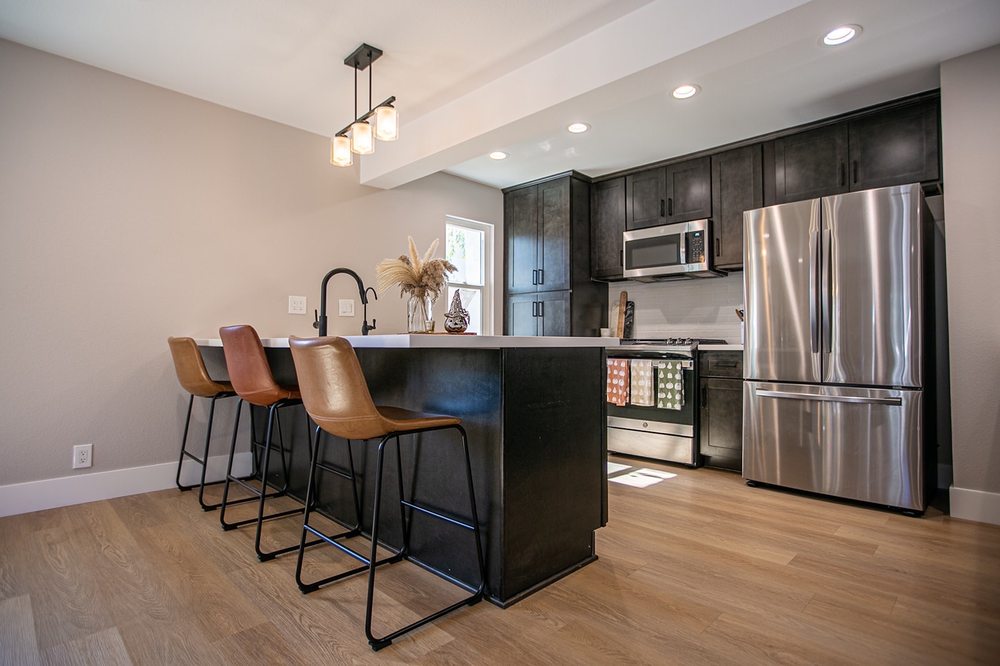
7 Common Mistakes to Avoid When Planning a Kitchen Remodel A kitchen remodel can be one of the most rewarding home renovation projects, transforming your space into a more functional and beautiful area. However, it’s also a complex process that requires careful planning. Mistakes during a remodel can lead to costly repairs, delays, and stress. The good news? Many of these mistakes are avoidable with the right preparation. In this guide, we’ll highlight the most common kitchen remodel mistakes and how to avoid them for a smooth and successful renovation. 1. Not Having a Clear Plan One of the most common mistakes homeowners make when planning a kitchen remodel is not having a clear, detailed plan in place. Without a solid plan, you could find yourself dealing with delays, budget overruns, and even design choices that don’t meet your needs. Why Planning Is Crucial? Before any demolition or purchases begin, you should have a detailed renovation plan that outlines the scope of work, layout, materials, and budget. This roadmap will guide you and your contractor through the process, helping to avoid last-minute changes that can derail the project. Pro Tip: Take the time to research kitchen designs, materials, and storage solutions before committing to any major decisions. 2. Underestimating the Budget Setting an unrealistic budget—or failing to account for unexpected expenses—is another mistake that can throw a kitchen remodel off track. It’s essential to create a budget that reflects the scope of the work and includes a buffer for surprises. Avoiding Budget Pitfalls Plan to set aside 10-20% of your budget for contingencies. Unexpected expenses, such as plumbing or electrical updates, can arise during a remodel, and having a cushion will prevent financial stress down the line. Pro Tip: Work with your contractor to get a detailed estimate and break down the costs. This will help you prioritize where to allocate your budget for the best return on investment. 3. Ignoring Functionality and Workflow It’s easy to get caught up in picking out beautiful countertops, cabinets, and appliances—but ignoring functionality can lead to long-term dissatisfaction. A kitchen that looks great but doesn’t function well can be frustrating to work in, especially if the layout disrupts the flow of cooking or cleaning. Prioritize the Work Triangle The kitchen work triangle—the optimal distance between the sink, stove, and refrigerator—should be at the core of your kitchen layout. This triangle ensures efficiency and makes cooking more seamless. Pro Tip: Focus on creating a layout that minimizes unnecessary movement, incorporates plenty of counter space, and provides easy access to essential appliances and storage. 4. Skimping on Quality Materials Trying to cut costs by choosing cheaper materials might save money upfront, but it can cost you in the long run. Poor-quality countertops, cabinets, or appliances may wear out quickly and require frequent repairs or replacements. Why Quality Matters? Investing in high-quality, durable materials like granite or quartz countertops, solid wood cabinets, and energy-efficient appliances ensures your kitchen will stand the test of time. Pro Tip: Opt for materials that balance both durability and style. Spending a little more now can prevent the need for costly replacements later. 5. Not Hiring the Right Professionals While DIY projects can be tempting, kitchen remodels often require professional expertise to avoid costly mistakes. Hiring inexperienced contractors or attempting complex renovations yourself can lead to issues that may not become apparent until later, causing further delays and expenses. How to Choose the Right Professionals? Hiring experienced kitchen remodelers is crucial for avoiding headaches down the road. Look for contractors with strong reviews, transparent pricing, and a portfolio of completed projects that align with your vision. Pro Tip: Don’t just choose the cheapest bid—consider the contractor’s experience, communication style, and reliability. 6. Poor Lighting Design Lighting is one of the most overlooked aspects of a kitchen remodel, but it plays a critical role in both the functionality and atmosphere of the space. Poor lighting can make it difficult to prep food, cook, and entertain, while also diminishing the aesthetic appeal of your new kitchen. Layering Lighting for Maximum Impact Effective kitchen lighting involves a mix of task lighting, ambient lighting, and accent lighting. Task lighting, such as under-cabinet lights, provides focused light where you need it most. Ambient lighting offers overall illumination, and accent lighting adds depth and highlights key design features. Pro Tip: Be sure to include ample lighting above countertops, islands, and cooking areas to ensure a well-lit and welcoming space. 7. Forgetting Storage Solutions One of the most frustrating kitchen remodel mistakes is not planning enough storage. A beautiful kitchen can quickly become cluttered if there’s nowhere to store pots, pans, utensils, and pantry items. Smart Storage Solutions Incorporating smart storage solutions into your kitchen design, such as pull-out drawers, deep cabinets, and a well-organized pantry, can maximize space and keep your kitchen tidy. Don’t forget vertical storage options, like tall cabinets that make use of ceiling height. Pro Tip: Think about how you use your kitchen on a daily basis, and design your storage to fit your specific needs. Conclusion A successful kitchen remodel requires careful planning, budgeting, and decision-making. By avoiding these common mistakes—such as not having a clear plan, underestimating your budget, and ignoring functionality—you can ensure your renovation goes smoothly and delivers the kitchen of your dreams. Avoid costly mistakes in your kitchen renovation by working with the experts at Michigan Rose Construction. Contact us today to get started on your dream kitchen, or call us at (734) 307-2019 to schedule a consultation or fill up the contact form below! NameEmailPhoneAddress*Files & PhotosLead SourceHow did you hear about us?FacebookGoogleInstagramInternet SearchReferralWebsiteYelpYardReachNotesTell us about your project!NotesWhat days and times work for you for an on-site consultation?Submit FREQUENTLY ASKED QUESTIONS: What is the most common mistake people make when planning a kitchen remodel? The most common mistake is not having a clear, detailed plan. Without a solid plan, you may face delays, budget overruns, and design choices that don’t meet your needs. It’s essential to outline
When to Hire a Professional vs. DIY for Kitchen Remodelling
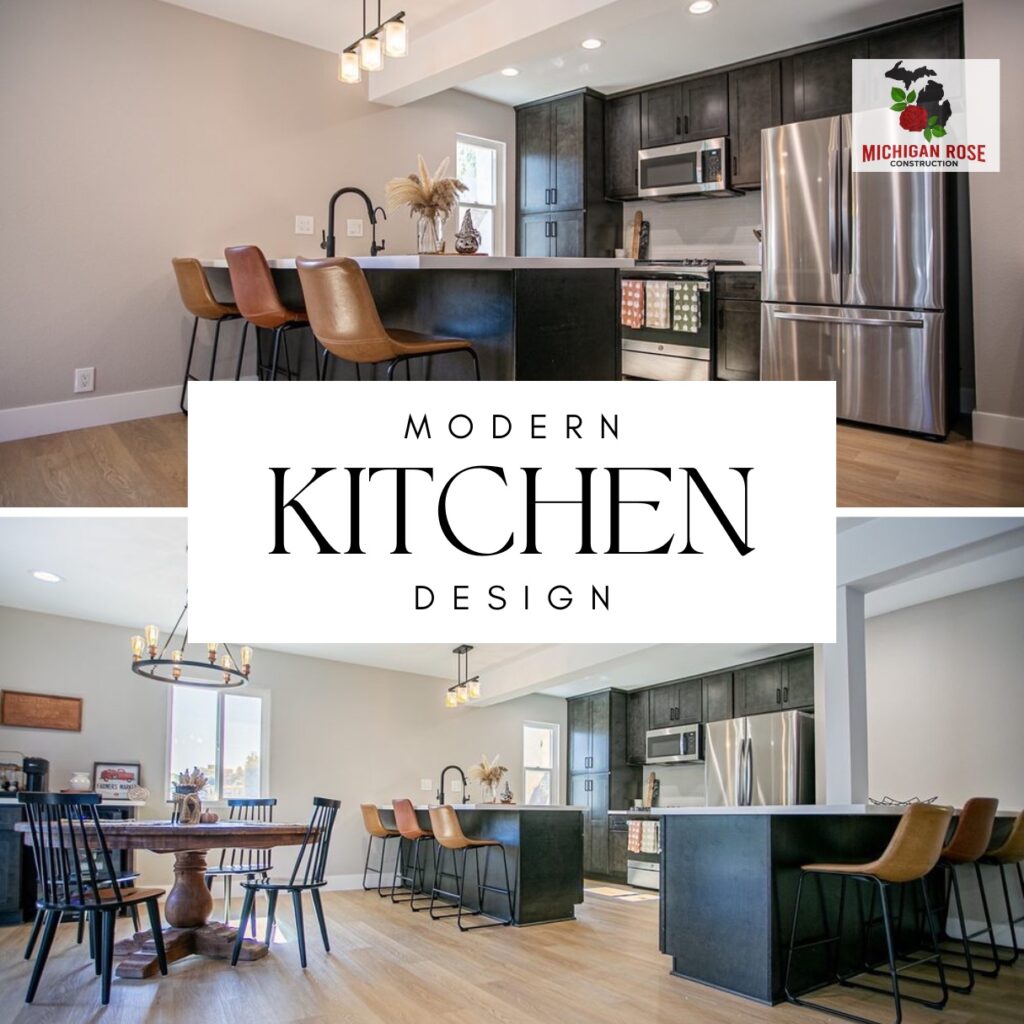
When to Hire a Professional vs. DIY for Kitchen Remodelling Taking on a kitchen remodel can be an exciting venture for homeowners, especially with the rise of do-it-yourself (DIY) projects. However, while DIY can be a cost-saving and rewarding experience, it’s essential to know which tasks you can handle yourself and when it’s best to call in a professional. Making the right decision can save you time, money, and future headaches. In this guide, we’ll help you navigate the choice between DIY kitchen remodeling and hiring a professional, ensuring your project goes smoothly and delivers the results you’re aiming for. Assessing the Scope of the Project The first and most critical factor in deciding between DIY and hiring a professional is the scope of your kitchen remodel. Smaller, cosmetic updates may be within reach for a handy homeowner, but more complex projects can quickly escalate in difficulty. DIY-Friendly Tasks vs. Complex Renovations DIY: Repainting walls, changing cabinet hardware, and updating light fixtures can often be done by homeowners with some experience. Professional Help: Major renovations like moving walls, rewiring electrical systems, or installing new plumbing should be left to licensed professionals. Understanding the complexity of the project can help you avoid common pitfalls and unnecessary expenses later on. DIY-Friendly Tasks for Your Kitchen Remodel If you’re looking to save money and enjoy a hands-on approach, there are several kitchen updates that are DIY-friendly for homeowners with the right tools and skills. These tasks are typically less invasive and require basic knowledge of home improvement. Common DIY Kitchen Remodelling Tasks Painting Walls and Cabinets: Refresh your kitchen with a new color palette by painting the walls or updating cabinet doors. Replacing Cabinet Hardware: A quick and easy way to modernize your kitchen is by swapping out old handles and knobs for sleek new designs. Installing Backsplash Tiles: For experienced DIYers, adding a backsplash can elevate the look of your kitchen and protect walls from spills. Changing Light Fixtures: Swapping out old lighting for modern fixtures can give your kitchen a stylish upgrade, provided there’s no complex electrical work involved. These tasks offer a balance of impact and simplicity, allowing homeowners to transform their space without the need for a professional contractor. When to Hire a Professional? While DIY projects can be fun, there are situations where it’s best to bring in a contractor. Tasks involving structural changes or compliance with building codes can present challenges that require specialized skills and knowledge. Scenarios for Hiring a Professional Structural Changes: Moving walls or adding new windows not only impacts the layout but also requires careful attention to safety and structural integrity. Plumbing and Electrical Work: These tasks must meet strict code regulations. Mistakes here can lead to expensive repairs and even safety hazards. Custom Cabinetry and Countertops: For a seamless, high-end look, professional installation ensures precision and durability. Redesigning the Floor Plan: If your remodel involves reworking the layout, professional designers and contractors can ensure the new design flows properly and enhances functionality. Hiring a contractor for these more complex aspects ensures your remodel is done correctly and can prevent costly errors down the line. Getting a Licensed Builder allows them to pull permits and do work for major renovations that require inspections. Changing the layout of your house without permits could cause issues beyond just having sub-par work done but also cause issues when trying to sell your home because the layout on the original plans do not align with the layout of the home, causing issues with the city and price for your home Budget Considerations: DIY vs. Hiring a Professional One of the biggest motivators for DIY kitchen remodeling is saving money. While it’s true that doing some tasks yourself can reduce costs, mistakes in more technical areas can quickly eat into your savings. DIY Savings vs. Potential Costs DIY Savings: Tackling painting or hardware updates yourself can save on labor costs, allowing you to allocate more of your budget to higher-end materials. Hiring a Professional: For tasks like electrical work or custom installations, investing in a professional can actually save money in the long run by avoiding costly repairs or mistakes. It’s crucial to weigh the immediate savings of DIY against the potential long-term costs of mistakes or incomplete work. Time and Skill Level: Can You Commit? Time is another key factor to consider before embarking on a DIY kitchen remodel. A professional contractor can complete projects on a set timeline, while DIY efforts may take significantly longer, especially if you’re juggling work and family responsibilities. Considerations for Time and Skill DIY: Be honest with yourself about how much time you can realistically dedicate. DIY projects often take longer than anticipated, particularly if you’re learning as you go. Hiring a Professional: Contractors have the experience and manpower to complete your project efficiently, saving you weeks or even months of labor. If you have limited time or skills, a professional contractor can get the job done faster and more efficiently. Long-Term Value and Resale Considerations When deciding between DIY and hiring a professional, it’s important to consider the long-term impact on your home’s value. Professional-quality work tends to add more value to your property, especially when it comes time to sell. Quality Work Boosts Home Value Home Resale Value: Kitchens are one of the top features that influence homebuyers, and high-quality workmanship will pay off in resale value. On the flip side, visible mistakes from DIY efforts can detract from your home’s appeal. Long-Term Savings: Investing in durable, professional-grade materials and workmanship ensures your kitchen stands the test of time, saving you on future maintenance and repairs. For homeowners looking to maximize their home’s resale value, hiring a professional for major renovations is a wise investment. Conclusion The decision between DIY and hiring a professional for your kitchen remodel comes down to scope, budget, time, and long-term goals. While DIY can be a rewarding way to personalize your home and save money, complex projects that impact safety,
Bathroom and Kitchen Designs
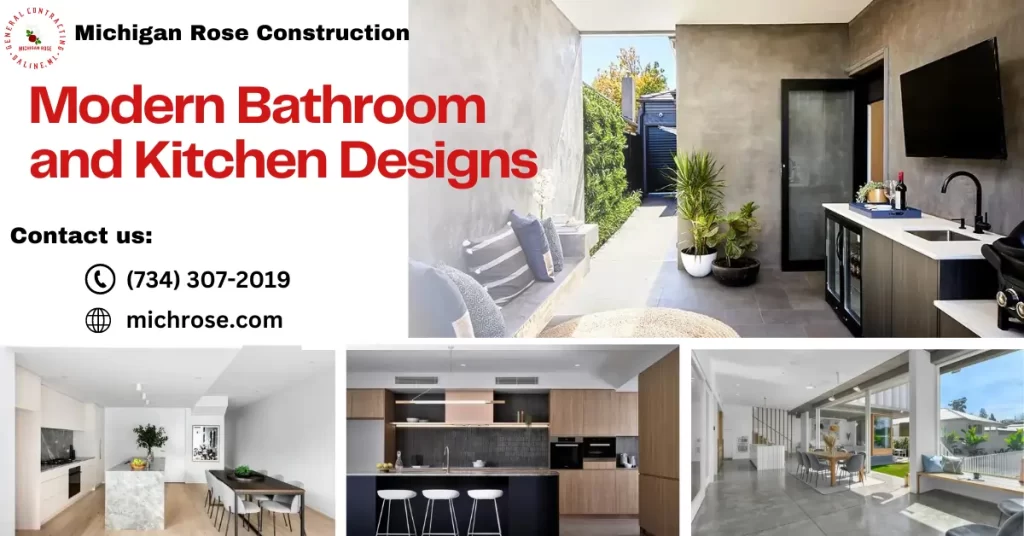
Modern Bathroom and Kitchen Designs That You Can’t Miss Introduction – The Latest Bathroom and Kitchen Designs Trend Are you interested to remodel your home? If so, you’re in for a real treat. Today’s bathroom and kitchen designs integrate cutting-edge technology, sustainable materials, and spa-inspired atmospheres to create stylish, functional spaces. This guide will explore the hottest trends in transforming bathrooms and kitchens. We’ll look at smart home tech, eco-friendly designs, accessibility features, and more. You’ll discover spacious layouts, soothing color palettes, and must-have fixtures shaping today’s most coveted spaces. Ready for an indulgent, high-tech home upgrade? Visit Michigan Rose Construction page and get inspired. Their expert team stays on top of the latest trends and can bring your dream designs to life. They also serve in the surrounding area of Walled Lake, West Bloomfield, Whitmore Lake, Wixom and Ypsilanti Michigan. The key looks and innovations define modern bathroom and kitchen designs. 1. What are the key trends you see filtering through into bathroom and kitchen designs? Bathroom and Kitchen Designs Minimalism: Less is More The minimalist philosophy of “less is more” has strongly influenced modern bathroom and kitchen designs. This trend focuses on decluttering, open space, and clean lines to create soothing sanctuaries for busy modern life. Minimalist kitchens feature hidden appliances, lots of bright white space, and almost surgical levels of organization. The goal is to remove visual clutter so the space feels open and fresh. Cabinets have discreet handles or are handle-free, with touch latches. Appliances are streamlined and kept to the essentials. Islands and open shelving reduce the need for upper cabinets. Bathrooms also embrace minimalism with spa-like spaces free of clutter. Floating vanities increase the sense of airiness. Neutral colors like white and light wood tones prevent sensory overload. Walk-in showers have integrated shelving and benches rather than standalone pieces. Any decorative accents are purposeful and sparing. The minimalist movement has influenced bathroom and kitchen designs to focus on clean, decluttered spaces that feel serene and open. With less visual noise, these rooms become relaxing personal sanctuaries. Smart Technology The latest bathroom and kitchen designs embrace innovative technology to enhance convenience, accessibility, and sustainability. Touchless faucets are increasing in popularity for their hygienic and hassle-free operation. With sensors or motion detectors, water can flow without turning a handle. Many offer options to adjust temperature, flow, and activation distance. Some high-tech faucets even have LED lights that change color based on water temperature. Beyond faucets, appliance manufacturers now offer refrigerators, ovens, microwaves, and dishwashers with Wi-Fi connectivity. New smart home capabilities allow users to remotely control, monitor, and schedule operations through an app. For example, check if you left the oven on at work and turn it off. Some appliances can reorder staples when supplies run low or help track expiration dates. Integrating voice assistants like Alexa allows hands-free control of appliances and other smart home devices. Imagine turning on your bathroom heater, setting the shower to your preferred temperature, and playing music just through voice commands. As homes get more innovative, expect to see even more integration in the spaces where we spend the most time – the bathroom and kitchen designs. Sustainability Sustainability is a key trend influencing modern bathroom and kitchen designs. Homeowners are increasingly concerned about environmental impact and want their spaces to reflect eco-friendly values. This translates to choosing materials, fixtures, and appliances that are sustainable and energy/water efficient. Renewable or recycled options like bamboo, reclaimed wood, recycled glass tiles, and renewable cork are growing in popularity for countertops and floors. These materials don’t deplete resources in the way that stone and hardwoods can. Faucets, showerheads, and toilets are now available with low-flow options significantly reducing water usage. EnergyStar-rated appliances also continue to grow in market share. Wellness Self-care and well-being are increasingly important in modern life. People want their homes, especially critical spaces like the bathroom and kitchen, to promote relaxation, rejuvenation, and overall wellness. This means integrating spa-like features to create a soothing ambiance. Showers and bathtubs can include built-in benches, therapeutic body jets, Bluetooth sound systems, and even chromotherapy lighting. Extractor fans, humidity control, and air purification systems also provide a calming environment. Personalization Adds Unique Flair Personalization and customization are growing as homeowners seek creative ways to express their styles. More clients want to put their unique stamp on their bathroom and kitchen designs through personalized accents and one-of-a-kind touches. Unique color palettes, custom cabinetry finishes, artistic tile designs, and specialty hardware offer opportunities to tailor the space. Mixing finishes like wood cabinets and marble countertops creates contrast and visual interest. Statement light fixtures or faucets showcase the homeowner’s personality. Monogramming and specialty engraved designs on surfaces bring in personalized details. Multifunctional Spaces Open-concept floor plans continue trending in modern bathroom and kitchen designs, with spacious layouts that promote flexibility. Multipurpose rooms allow the space to easily transition for different needs, whether cooking, working, or entertaining. An open design creates seamless integration between the kitchen, dining, and living areas. The absence of walls makes the home feel more expansive and facilitates natural conversation and connection between people in different parts of the house. Such open layouts demand intelligent storage solutions, like pull-out shelves, spice racks, and other organizational tools that consolidate items. Tucking appliances away into cupboards or sliding them behind closed doors maintains a streamlined appearance. Islands on casters add movable prep space and can double as informal dining areas. Built-in benches maximize seating while keeping the look cohesive. Natural Materials Natural materials like stone, wood, marble, and organic textiles are making a comeback in modern bathroom and kitchen designs after years of favoring artificial materials like laminate, quartz, and porcelain; designers and homeowners are returning to the beauty and character of real wood, natural stone, and other materials sourced straight from nature. Wood remains one of the most popular choices for cabinetry, floors, furniture, and architectural accents. Woods like oak, maple, and walnut have a warm, organic aesthetic that fits well with traditional and
Kitchen and Bathroom Countertops
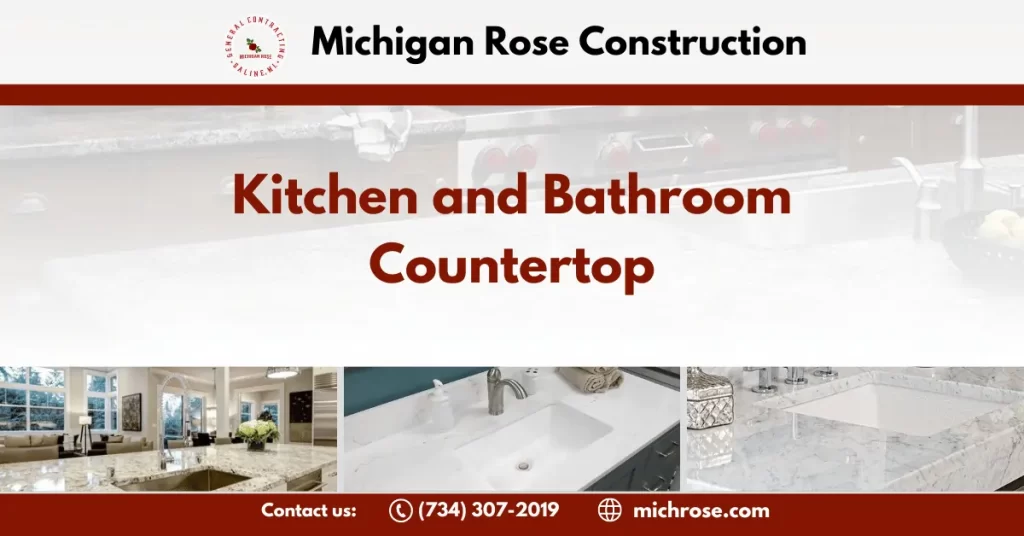
Kitchen and Bathroom Countertops: Introduction Welcome to our guide on kitchen and bathroom countertops near Ann Arbor, MI! If you’re in the process of designing or remodeling your kitchen or bathroom, choosing the right countertop material is one of the most important decisions you’ll make. The countertops are a major focal point and get used every single day, so you want to select a material that is practical, beautiful, and fits within your budget. In this post, We’ll draw upon our expertise to provide helpful insights on the most popular kitchen and bathroom countertops options, their pros and cons, and factors to consider when selecting your new countertops. Whether you prefer natural stone, engineered materials, tile, wood, or even laminate, We’ll make sure you have all the information you need to make the perfect choice for your home. Let’s dive in! Countertop Materials When selecting a countertop for your kitchen and bathroom countertops, there are many materials to consider that each have their own pros and cons. Through my 10 years of experience as a contractor, here are the most popular countertop options: Granite Countertops Granite is one of the most popular choices for kitchen and bathroom countertops due to its natural beauty and durability. Here are some of the key factors to consider with granite countertops: Pros Cons Maintenance Granite’s natural beauty and durability make it a luxurious and lasting choice. With proper sealing and care, granite countertops can remain in great shape for decades. The high upfront cost is offset by the value and elegance granite adds to a kitchen or bathroom. Marble Countertops Marble is a classic and elegant choice for kitchen and bathroom countertops. As someone who has installed countertops professionally, we have extensive first-hand experience working with marble in homes. Pros of Marble Countertops: Cons of Marble Countertops: Maintenance for Marble Countertops: With proper care and maintenance, marble countertops can stay beautiful for decades and are a worthwhile investment for many homeowners seeking timeless, classic elegance. The smooth, cool surface adds luxury and sophistication to any kitchen or bath. Quartz Countertops Quartz countertops are engineered stone made from crushed quartz blended with resins and pigments. They have become an increasingly popular option for kitchen and bathroom countertops in recent years. Here are some key things to know about quartz: Pros Cons Maintenance Quartz offers the look of natural stone with excellent durability and less maintenance. The range of styles and colors makes it adaptable for nearly any kitchen or bath. With routine care, quartz countertops will retain their beauty for many years. Laminate Countertops Often overlooked, laminate countertops remain a popular and affordable choice for many homeowners and renters. Laminate countertops, also known as “plastic laminate,” are made by fusing plastic resin with layers of kraft paper. This process creates a durable, seamless surface that resists stains, scratches, burns, and moisture damage. Pros Cons Laminate countertops can be an excellent choice for rental properties, starter homes, or quick kitchen makeovers on a tight budget. With proper care and maintenance, laminate countertops can last 10-20 years. Just avoid abrasive cleaners, hot pots/pans directly on the surface, and sharp objects that could scratch or gouge the laminate finish. Overall, laminate delivers an affordable, low-maintenance countertop option. Wood Countertops Wood countertops can add natural warmth and beauty to any kitchen or bathroom. Made from various types of wood like oak, maple, walnut, and bamboo, they have some unique advantages and disadvantages compared to other countertop materials. Pros of Wood Countertops: Cons of Wood Countertops: Cost of Wood Countertops: The average price of wood countertops ranges from $40-$100 per square foot installed. The specific wood type used and finishing details will impact the overall cost. More exotic and durable hardwoods like teak, walnut, or mahogany will be more expensive. Maintaining Wood Countertops: With proper care and maintenance, wood can be a warm yet functional countertop material that adds natural flair to any space. Considering the pros, cons, and costs allows homeowners to make the best selection for their needs and budget. Tile Countertops Tile can be an attractive and affordable option for kitchen and bathroom countertops. Here are some of the main pros and cons of tile countertops: Pros: Cons: Pricing: Tile pricing varies dramatically. Ceramic tile starts around $2 per square foot. Porcelain, stone, glass and other tiles can range from $5-$50 per square foot or more. Material cost is just one part of the total project cost. Professional installation, mortar, grout, sealant and labor will also factor in. Maintenance: Tile requires regular cleaning with a non-abrasive cleaner. Re-sealing grout lines annually will protect against stains and mildew. Cracked or damaged tiles can be replaced individually. Selecting a Countertop When selecting a bathroom and kitchen countertops, there are several important factors to consider: As an expert tip, be sure to explore all the design possibilities before deciding on a material. Get creative with patterns, edges, inserts, and accents to make your kitchen and bathroom countertops truly unique. An experienced countertop professional can help advise on the best options for your needs, budget and style. See Home Remodeling in Ann Arbor MI Conclusion Deciding on new kitchen and bathroom countertops can be an exciting experience, but also requires careful consideration of the pros and cons of different materials. In this article, we’ve covered the most popular kitchen and bathroom countertops options like granite, marble, quartz, laminate, wood, and tile. When selecting your new kitchen and bathroom countertops, be sure to think about your lifestyle, budget, and design aesthetics. Granite and marble are classic natural stone choices that add elegance, while more affordable laminate and tile can mimic the look of other materials. Maintenance is also a key factor – quartz and laminate are low maintenance, while marble requires more sealing and care. At the end of the day, you want your kitchen and bathroom countertops that will stand the test of time and suit your needs. Focus on finding a material that fits within your budget but doesn’t
































